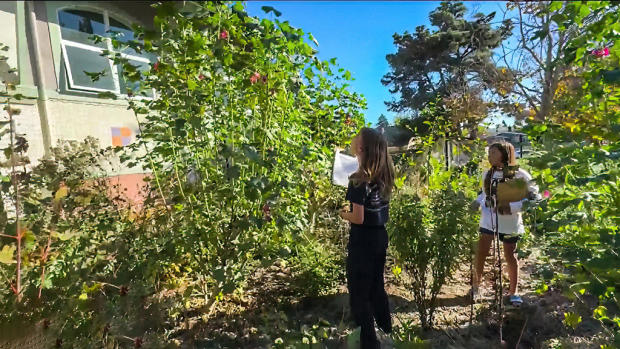BERKELEY — On a busy street corner in South Berkeley, a small-scale revolution is taking root.
Instead of pavement or a manicured lawn there’s a dense little pocket of native plants and saplings that are flourishing in rich soil in front of the Berkeley Technology Academy.
It’s called a Miyawaki or micro-forest.
“They grow much faster and they use less water, which is very, very good,” explained 5th grader Lia Mykita-Montesdeoca.
Some fifth graders from a nearby school are tracking the Miyawaki’s growth.
“It smells really good,” exclaimed 5th grader Itzel Escamilla Geisler.
“I saw a few bees,” added her classmate, Lucia Halty.
KPIX
Less than a year ago, these four students helped to plant the seedlings.
“You followed a group, you dug a hole and carefully spread out the roots and put the tree in the ground,” fellow student Elia Faerbeach said.
The seedlings have grown quickly into plants and small trees. Overseeing the project is science teacher Neelam Patil.
“The reason we are planting the Miyawaki forests and using the Miyawaki method is to address climate change,” Patil said.
For years, Neelam has taught her students about the dangers of climate change.
Now she’s showing them what they can do about it — by planting these tiny fast-growing forests.
“I like to call it a symphony of nature,” Neelam said when asked why they grow so rapidly.
The Miyawaki method first restores the soil and then packs together only native flora plantings. It’s named after late Japanese botanist Akira Miyawaki, who did the research and developed the method.
Studies show how these tiny forests grow 10 times faster and sequester more excess carbon in the atmosphere.
The tiny groves also reduce the urban heat-island effect and filter the air.
They also quickly become a cradle for renewed biodiversity — which is currently under threat as the planet continues to warm.
“We’re basically facing 40 percent biodiversity loss by the end of the decade and we need solutions and the Miyawaki forest is a very effective and efficient system,” Patil said.
So far, students and volunteers have planted Miyawaki forests at four schools in Berkeley. Now there’s a chance they can grow more.
“The city owns a lot more land in Berkeley than schools,” said Berkeley city council member Sophie Hahn.
Hahn has recommended funding a new pilot program. It would plant two new Miyawaki forests. This time, the focus would not be on schools but on city sites, especially near freeways, where there’s poor air quality and fewer trees.
“It’s impacting our low-income neighborhoods and our communities of color more than anyone else,” Hahn explained.
Patil and Hahn are keenly aware that the younger generations feel anxious and depressed about the future but these children who are involved in planting Miyawaki forests feel inspired.
“When I look at it, I feel very proud and I am happy that I’m helping the world,” Mykita-Montesdeoca said.
WEBLINKS
The Miyawaki Method for Creating Forests
Councilmember Sophie Hahn recommendation to Berkeley City Council (PDF)
Denial of responsibility! My Droll is an automatic aggregator of Global media. In each content, the hyperlink to the primary source is specified. All trademarks belong to their rightful owners, and all materials to their authors. For any complaint, please reach us at – [email protected]. We will take necessary action within 24 hours.



